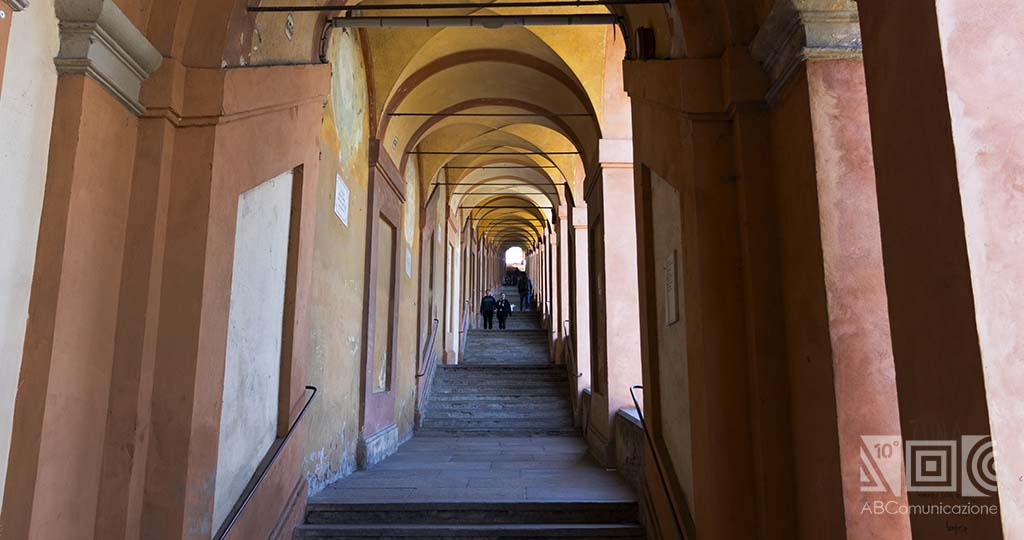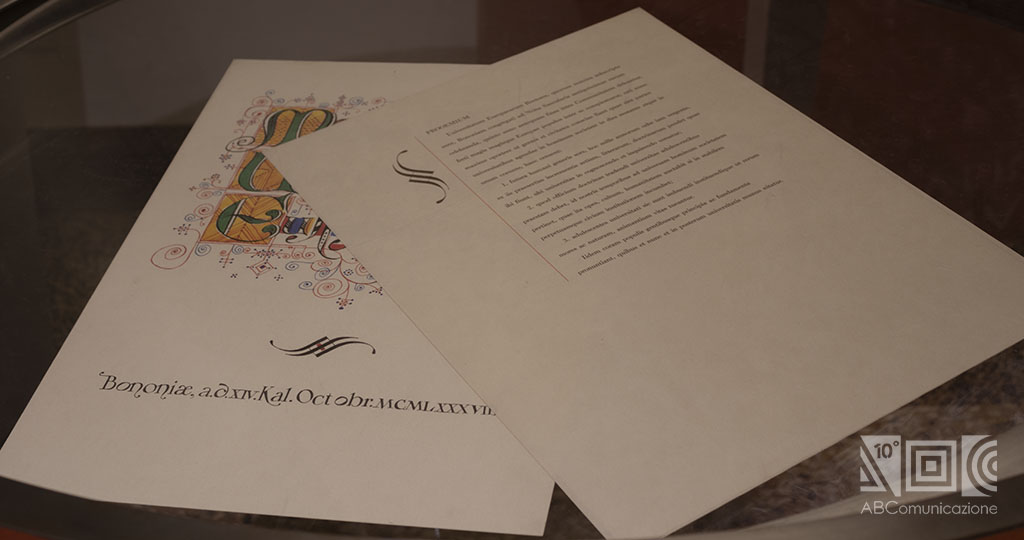Do you know that Bologna is the oldest University of the western world? What is the relationship between the porticoes of Bologna and the University of Bologna? Discover with us the history of the University and the great minds that made it famous!
How was the University of Bologna born?
An historical and social background
After a period of severe decline between the 4th and 8th century, around the year 1000 AC, we can see the beginning of a social and economic recovery in Bologna. It is due to numerous factors, but the trigger can be identified in the creation of “Via di Monte Bardone”. This route began in France and showed pilgrims in prayer the way to the tomb of the Apostle Peter in Rome. The path then continued to the Holy Land, Jerusalem.
After the domination of the Lombards, the Franks changed its name to Via Francigena, which means “road originated from France”. At that time, the route traffic grew, and therefore the path established itself as the main link between North and South Europe, along which merchants, armies and pilgrims passed.
The Via Francigena was the engine of a very fast population and economic growth. This explained the increase of the city-population, to which follows an intense urbanization. In fact, Soon the Municipality of Bologna realized that, in order to support its autonomy from the Empire, it needed to train capable professionals.
So how was the University of Bologna born? In this period, Bologna sees the birth of many conflicts between the Papacy and the Empire (among which we remember the “Investiture Controversy”). These clashes stimulated the interest in the city’s political affairs and the attention to legal aspects and Roman law. Thanks to these propitious circumstances, the reputation of the Studium spread and it attracted to Bologna numerous students; only a few of them were pilgrims thirsting for science. From these premises was born the Studium of Bologna, mainly focused on the study of Law.
The oldest University of the Western world
The Studium of Bologna was in 1088 a.d. born, centered on the teaching of Law. Bologna preceded the other universities, which will be formed at the beginning of the Renaissance around 1420 a.d.: that is why it is considered the oldest university in the Western world still in operation. The excellence that has always characterized the University of Bologna is so recognized that the city earned the nickname “La Dotta”. In addition to that, the University of Bologna established itself as an autonomous institution that is independent of any form of power, attracting personalities from all over the world.

An interesting fact that concerns the University of Bologna is the choice of the Rector. In the past he was a student who was elected by a vote every year. Some basic requirements to be elected were being at least 25 years of age and possessing assets that would allow him to support the huge expenses that the position provided. Among his duties we can find the regulation of the internal organization of the University, the timetable of the lessons and the days of vacation.
Bologna, which at that time was a small city, soon faced the housing problem due to the large number of merchants, pilgrims and now students and academics who began to attend university.
The Studium of Bologna was also very renowned in the world. Foreign students often gathered in groups according to the country they belonged to and stayed in boarding schools, as in the case of the Collegio di Spagna which since the fourteenth century still operates in its historic location.
Which solutions has Bologna adopted to solve the ever-increasing demand for housing? The porticoes were a key element, find out with us!
The porticoes and the University of Bologna
Bologna is also known as the “city of porticoes”, which extend for 53 kilometers between the city center and the territory outside the walls.
Why have the porticoes been developed so much in Bologna? Their construction began in the Early Middle Ages to enlarge the space of the houses. As we saw in the previous paragraph “The oldest university in the Western world“, the development and affirmation of the University of Bologna attracted lots of students and academics. So, they needed to settle in a still very small city ready to burst demographically.
The arcades proved to be an excellent solution to solve the housing emergency that had been created. They allowed the expansion of the upper floors of the houses, without the necessity to create new buildings.
Initially, they were only carrier beams that protruded like balconies. Later on, due to the frequent collapses, the columns were added in order to unload on the ground the increasing weight of the buildings: this is how the real porticoes were born.
Besides solving the problems caused by the large influx of people, the porticoes allowed to shelter from the weather. Their artistic relevance and their architectural characterization make them candidates to become a UNESCO World Heritage Site.

Do you want to find out more about the porticoes of Bologna? Do not miss the article The porticoes of Bologna: UNESCO World Heritage.
Where were the offices of the University of Bologna located? Read on and you will find out!
The offices of the University of Bologna
The lessons of the Studium of Bologna were initially held in different places in the city, often at the home of the professor of the course with whom the students stipulated private agreements. Other times teachings took place in churches and convents.
The increasing number of students created the need to realize an unitary place for teaching, from which the various offices of the University of Bologna were born.
Since the Studium of Bologna was born in 1088 a.d. in different locations of this small city, it is not surprising that the current offices are located in historic buildings in the city center. The faculties of Law and Medicine are those that from the beginning had a broader and more rapid development. After them more faculties were created and in a short time they reached the first two.
Archiginnasio Palace
The first official headquarter of the University of Bologna was established in the Archiginnasio Palace in Piazza Galvani 1, just behind the Church of San Petronio.

Inside the Archiginnasio Palace you can visit the first anatomical room of the University of Bologna, where Anatomy lessons were held. It is also known by the name of “Anatomical Theater” for its characteristic shape, at the center of which we can still find the original operating table.
With the construction of the first headquarter, all the various schools were located in one place. Furthermore, teachers began to be paid by the Municipality, partly losing their autonomy as “freelancers”.

Inside the building it is possible to admire a huge collection of heraldic coats of arms that commemorate students and teachers who attended and taught at the University of Bologna.
Palazzo Poggi
Then the headquarter of the University of Bologna was moved to Palazzo Poggi, in St. Zamboni 33 due to Napoleone. At the time, the well-known Institute of Sciences, founded by the scientist Luigi Ferdinando Marsili, was housed inside the building.

A curiosity about Palazzo Poggi concerns its Specola tower. The Specola tower was added after the construction of the building and it was the office of the Department of Astronomy of the University of Bologna, now transformed into a museum. In addition to that, on a desk of the University of Bologna at Palazzo Poggi you can discover one of the Seven Secrets of Bologna: the inscription “Panum resis”, which means that culture is the basis of everything.
Palazzo Marescotti Brazzetti
Another office of the University of Bologna located in a historic building is the Department of Visual, Performing and Medial Arts (DAMS degree course), at Palazzo Marescotti Brazzetti. Located in St. Barberia 4, the building was born as a private residence. On the inside we can find the Library of Music and Entertainment of the University of Bologna. Music has a very important role for Bologna as you can discover in the dedicated article Bologna city of music.
The establishment of new offices for different disciplines allows to absorb the huge turnout of students and academics of great caliber. Among these people, we can also identify very important international figures.
The “great minds” of the University of Bologna
The first famous students of the University of Bologna were Pepone and Irnerio, both very famous jurists, considered as historical figures relevant to the discipline of Law and the creation of the Studium.
Other very important personalities who attended the University of Bologna are the poet Torquato Tasso and the playwright Carlo Goldoni, Niccolò Copernico, famous for his contributions to astronomy and Thomas Becket, who will become a well-known Catholic archbishop.
Among the students of the Alma Mater Studiorum in Bologna we also find Laura Bassi, an Italian physics student who was the second woman graduated in Italy to obtain a chair in physics.
The University of Bologna has also seen the presence of many famous teachers, including Ulisse Aldrovandi (discover with us his Botanical Garden), Umberto Eco and Giosuè Carducci.
Another figure that stands out is Gaspare Tagliacozzi, who completed his first studies in plastic surgery in the XVI century.
Giovanni Capellini
The first chair of Geology in Italy was established at the University of Bologna. The first professor and geologist to occupy the chair was Giovanni Capellini who created the Museum of Geology in 1860, that opened only in 1881 thanks to the Second International Geological Congress.

Guglielmo Marconi
In 1907, the Institute of Physics in Bologna was inaugurated, founded by Augusto Righi. He was a very successful academic in Italy and abroad who began his career with the study of electromagnetic waves. His lectures were also attended by Guglielmo Marconi, who was born in Bologna in 1874. He made the first transoceanic radio broadcast in 1901. This revolutionary event for the telecommunications sector led the School of Engineering of the University of Bologna to praise him with an honorary degree.
In 1940, the Institute of Electronics of the University of Bologna took the name of Institute of Electrical Engineering and Electrical Communications “G. Marconi” thanks to Professor Vittorio Gori. Only in 2011 the name was changed to the Department of Electrical and Information Engineering “Guglielmo Marconi”.
At the age of 35, in 1909, Guglielmo Marconi won the Nobel Prize in Physics. It was the result of hard work that lasted about 15 years.
The Guglielmo Marconi Foundation, a museum dedicated to the birth and development of radio communications, is located in Sasso Marconi, a town named as it thanks to the scientist.
Umberto Eco
Umberto Eco was another very important figure for the University of Bologna. He was a semiologist, philosopher and a teacher and he also created two degree courses: Disciplines of Arts, Music and Entertainment (DAMS) in the early 1970s and Communication Sciences, of which he was the director.
In the 2000s the Higher School of Humanities of the University of Bologna was founded, which in 2017 was renamed the International Center for Humanities “Umberto Eco”. It was Umberto Eco who presided over it until his death.
Umberto Eco was also titled professor emeritus in 2008 and in 2015 was given to him the Golden Sigillum Magnum of The University, the highest academic honor awarded by the University of Bologna. In 2016 was also dedicated to him the “Piazza Coperta” inside the Salaborsa Library in Bologna. Discover its history in the article The Salaborsa Library and its incredible uses over time.

If you want to discover with us some of the best museums in town, even in the university area, don’t miss to read this article: Museums in Bologna: a must-see heritage.
The University of Bologna today
Educational excellence, international openness and cutting-edge research are some elements that still characterize the University of Bologna today.
On the 900th anniversary of the foundation of the Alma Mater Studiorum, the rectors of 430 international universities signed the Magna Charta Universitatum Europaeum. The document determines the founding characteristics of the university system (freedom, knowledge, research and teaching), centered on the importance of cooperation and links between universities around the world.

From the Studium focused on the law from where we began, the University of Bologna has expanded more and more towards other areas of knowledge. Now it offers 232 courses of study, including bachelor’s degrees and master’s degrees.
The University of Bologna has 5 campuses divided throughout Emilia-Romagna, including Cesena, Forlì, Ravenna, Rimini, Bologna and a Buenos Aires headquarter, inaugurated in 1998.
The cultural liveliness of the city, due to the success of the University of Bologna, is also evidenced by the Freshmen’s Festival, dating back to the first half of the twentieth century. In this event, Bologna was kindly handed over to the students, who would be the masters of the city for three days. The Freshmen’s Festival was a kind of carnival, in which many extravagant events and shows of all kinds were organized. This anniversary attracted young people from all over Italy for many years, until its suppression in the 1970s. Now you know why many students from all over the world choose the University of Bologna for their studies, making it one of the most attended universities at a national level. All you have to do is visit it!
If you are in this area, at “aperitivo” time, you cannot miss this appointment: here are some tips on which place to go!
Bibliografia
- Costa T., Bologna dalla A alla Z, Bologna, Costa Editore, 2011
- Menarini A., Vianelli A., Leggende e curiosità, Bologna, Tamari Editori, 1976
- Ferraris R., La via Francigena. 1.000 km a piedi dal Gran San bernardo a Roma, Milano, Terre di Mezzo, 2018
- Bernabei G., I portici di Bologna, Bologna, Santarini, 1992
- Falciasecca G., Valotti B., Guglielmo Marconi. Genio, storia e modernità, Milano, Editoriale Giorgio Mondadori, 2003
- Neri L., Umberto Eco. Una nuova idea di cultura, Bologna, Diogene Multimedia, 2021




